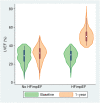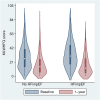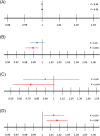Quality of life in patients with heart failure and improved ejection fraction: one-year changes and prognosis
- PMID: 35916351
- PMCID: PMC9773756
- DOI: 10.1002/ehf2.14098
Quality of life in patients with heart failure and improved ejection fraction: one-year changes and prognosis
Abstract
Aims: The criteria for patients with heart failure (HF) and improved ejection fraction (HFimpEF) are a baseline left ventricular ejection fraction (LVEF) ≤40%, a ≥10-point increase from baseline LVEF, and a second LVEF measurement >40%. We aimed to (i) assess patients with HF and reduced LVEF (HFrEF) at baseline and compare quality of life (QoL) changes between those that fulfilled and those that did not fulfil the HFimpEF criteria 1 year later and (ii) assess the prognostic role of QoL in patients with HFimpEF.
Methods: We reviewed data from a prospective registry of real-world outpatients with HF that were assessed for LVEF and QoL at a first visit to the HF clinic and 1 year later. QoL was evaluated with the Minnesota Living with Heart Failure Questionnaire (MLWHFQ). The primary prognostic endpoint was the composite of all-cause death or HF hospitalization.
Results: Baseline and 1-year LVEF and MLWFQ scores were available for 1040 patients with an initial LVEF ≤40% (mean age, 65.2 ± 11.7 years; 75.9% men). The main aetiology was ischaemic heart disease (52.9%), and patients were mostly in New York heart Association Classes II (71.1%) and III (21.6%). At baseline, the mean LVEF was 28.5% ± 7.3, and the mean MLWHFQ score was 30.2 ± 19.5. After 1 year, the mean LVEF increased to 38.0% ± 12.2, and the MLWHFQ scores improved to 17.4 ± 16.0. In 361 patients that fulfilled the HFimpEF criteria (34.7%), significant improvements were observed in both LVEF (from 28.7% ± 6.6 to 50.9% ± 7.6, P < 0.001) and QoL (from 32.9 ± 20.6 to 16.9 ± 16.0, P < 0.001). Patients that did not fulfil the HFimpEF criteria also showed significant improvements in LVEF (from 28.4% ± 7.6 to 31.1% ± 7.9, P < 0.001) and QoL (from 28.7 ± 18.8 to 17.6 ± 15.9, P < 0.001). However, the QoL improvement was significantly higher in the HFimpEF group (-16.0 ± 23.8 vs. -11.1 ± 20.3, P = 0.001), despite the worse mean baseline MLWHFQ score, compared with the non-HFimpEF group (P = 0.001). The 1-year QoL was similar between groups (P = 0.50). The 1-year MLWHFQ score was independently associated with outcomes; the hazard ratio for the composite endpoint was 1.02 (95% CI: 1.01-1.03, P = 0.006). In contrast, the QoL improvement (with a cut-off ≥5 points) was not independently associated with the composite outcome.
Conclusions: Patients with HFrEF showed improved QoL after 1 year, regardless of whether they met the HFimpEF criteria. The similar 1-year QoL perception between groups suggested that factors other than LVEF influenced QoL perception. The 1-year QoL was superior to the QoL change from baseline for predicting prognosis in patients with HFimpEF.
Keywords: Heart failure; Heart failure with improved ejection fraction; Left ventricular ejection fraction; Outcomes; Quality of life.
© 2022 The Authors. ESC Heart Failure published by John Wiley & Sons Ltd on behalf of European Society of Cardiology.
Conflict of interest statement
None declared.
Figures



References
-
- Moradi M, Daneshi F, Behzadmehr R, Rafiemanesh H, Bouya S, Raeisi M. Quality of life of chronic heart failure patients: A systematic review and meta‐analysis. Heart Fail Rev 2020; 25: 993–1006. - PubMed
-
- Quittan M, Wiesinger GF, Crevenna R, Nuhr MJ, Posch M, Hülsman M, Müller D, Pacher R, Fialka‐Moser V. Cross‐cultural adaptation of the Minnesota living with heart failure questionnaire for German‐speaking patients. J Rehabil Med 2001; 33: 182–186. - PubMed
-
- Parajón T, Lupón J, González B, Urrutia A, Altimir S, Coll R, Prats M, Valle V. Use of the Minnesota living with heart failure quality of life questionnaire in Spain. Rev Esp Cardiol 2004; 57: 155–160. - PubMed
-
- Gastelurrutia P, Lupón J, Altimir S, de Antonio M, González B, Cabanes R, Cano L, Urrutia A, Domingo M, Zamora E, Díez C, Coll R, Bayes‐Genis A. Effect of fragility on quality of life in patients with heart failure. Am J Cardiol 2013; 112: 1785–1789. - PubMed
-
- Hole T, Grundtvig M, Gullestad L, Flønæs B, Westheim A. Improved quality of life in Norwegian heart failure patients after follow‐up in outpatient heart failure clinics: Results from the Norwegian heart failure registry. Eur J Heart Fail 2010; 12: 1247–1252. - PubMed
Publication types
MeSH terms
LinkOut - more resources
Full Text Sources
Medical
Research Materials
Miscellaneous

